- Home
- /
EXERCISES TO RELIEVE CONSTIPATION - THE COMPLETE GUIDE
- Medically reviewed by: Horia Marculescu, MD
- Photo credits: Licenses / Author
- Last updated: 22.04.2022
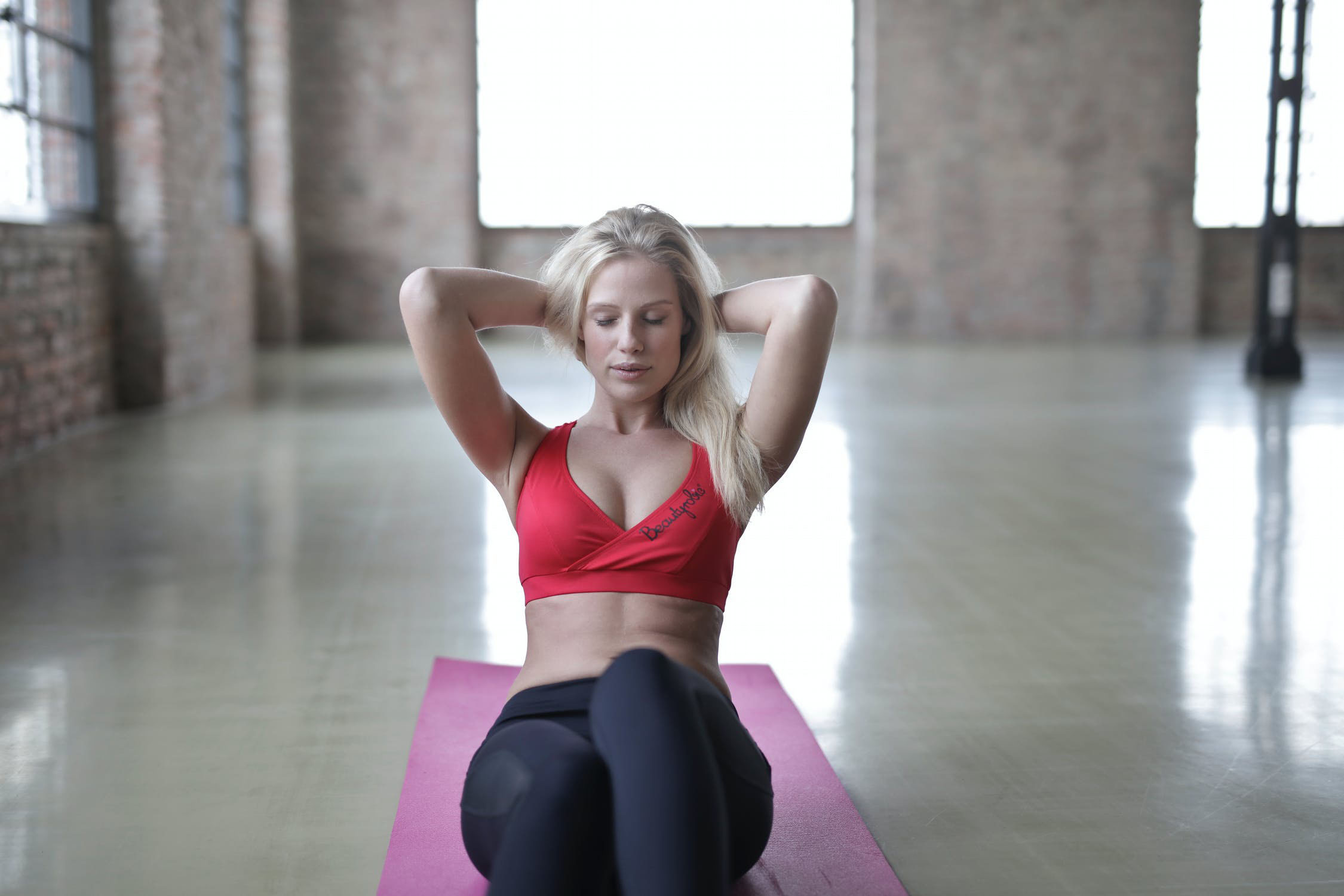
If you are looking for ways to deal with constipation in the long term, then try the following exercises to relieve constipation:
Crunches, sit-ups, walking, jogging, swimming, jump-rope, deep squat, supine twist, cobra stretch, wind-relieving pose, clockwise hip stretch, and up and down shoulder stretch.
Exercising is an easy and practical way to relieve constipation in the long term.
Cardio exercises, stretching, body twists, and yoga help stimulate bowel movement and make stool evacuation feel natural.
You can use them for stress relief, strengthening your body, building endurance resistance, and sculpting your abdomen.
Follow the guide to learn which one is the best for you.
- TABLE OF CONTENTS
- 1. CRUNCHES
- 2. SIT-UPS
- 3. WALKING
- 4. JOGGING
- 5. RUNNING
- 6. SWIMMING
- 7. JUMP ROPE
- 8. DEEP SQUAT
- 9. SUPINE TWIST
- 10. COBRA STRETCH
- 11. WIND-RELIEVING POSE
- 12. CLOCKWISE HIP STRETCH
- 13. UP AND DOWN SHOULDER STRETCH
- WHEN IS THE BEST TIME TO EXERCISE?
- WHEN TO EXERCISE DURING THE DAY?
- WHAT TO EAT BEFORE WORKOUT?
- KEEP IN MIND
- SUMMARY
1. CRUNCHES
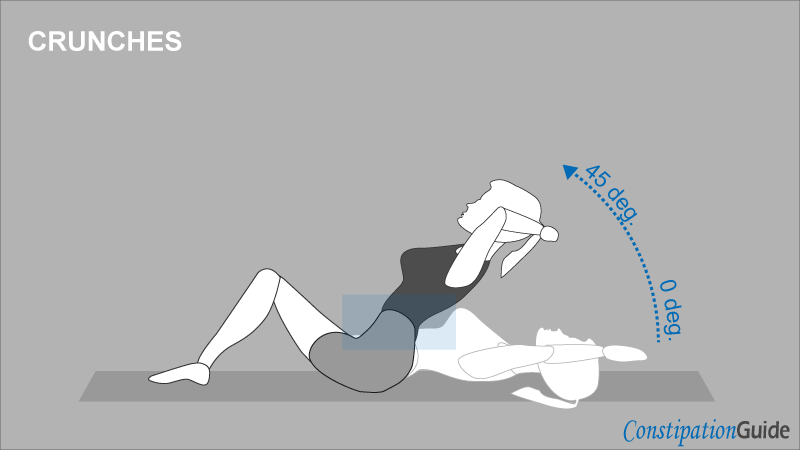
Crunches are one of the best exercises to relieve constipation. The reason: they put to intense work the abdominal muscles.
Also, crunches create pressure inside the intestines by contracting, squeezing, and moving the intestines.
Start to warmup with 5-10 slow crunches. Continue with 10-15 crunches and pause. Repeat this exercise 3-5 times slowly.
Crunches are excellent exercises to stimulate bowel movement and to simulate the natural squeezing of intestinal muscles.
The better these muscles squeeze, the better the stools will move out.
These exercises increase your breathing and heart rate. They also stimulate every muscle and nerve located in the abdominal area. As a result, your body will work more efficiently.
According to a study about the effects of whole-body vibration on Lumbar-abdominal muscle activation, published by The U.S. National Center for Biotechnology Information:
The results show that crunches are great for the abdominal muscles (in general, crunches are the best exercises for ab-workout).
2. SIT-UPS
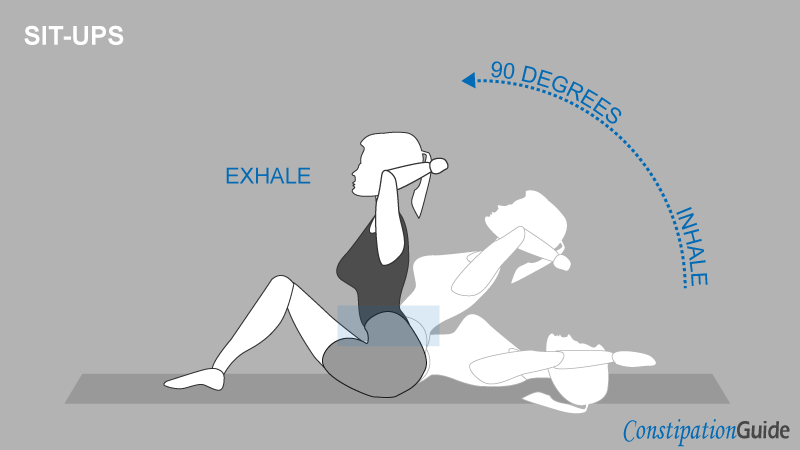
Sit-ups are almost identical to crunches and they have the same results as crunches.
The only difference between these two is that: the body rotates ninety degrees (instead of forty-five – crunches).
By rotating that much, you will have a complete abdominal workout.
Also, the movement will stimulate the nerves around the pelvic floor muscles, the hips, and the legs.
Sit-ups are slower versions of crunches because the hips and the bottom need to support the weight of the entire upper body.
And keep them in a vertical position for longer than when doing crunches.
According to a guide about physical activity in adults, published by The U.S. Department of Health: Adults should sit as little as possible and should move more throughout the day. Physical activity is beneficial for health overall.
3. WALKING

Walking is one of the best exercises to relieve constipation because it requires little effort for most people, most of the time.
The only thing that walking requires is a good pair of running shoes and a park. You can walk anywhere, at any time, but the environment should have fresh air.
Filling the lungs with fresh air will give you more energy and will increase blood flow. Walking is a slow and synchronized body movement that focuses on the legs (ankles, heels, knees).
It is essential to walk for at least sixty minutes, once every two days (70-90 minutes would be better).
But for most people, most of the time, 60 minutes is enough to start.
Warm-up with 10-15 minutes of slow walking and then continue with the rest with brisk walking.
Walking is an exercise that anyone can practice, regardless of their fitness level. It is inexpensive, and there are many ways to practice it like, brisk walking, walking the dog, or walk to work.
4. JOGGING

Jogging is one of the best cardio exercises to relieve constipation suited for anyone. You can go jogging on a running court, in a park, and why not, outside in nature.
Similar to walking, jogging involves the synchronized movements of the legs and arms. These movements work the legs and the lower abdomen at the same time.
The intensity of jogging is higher than brisk walking. It is right in the limit between brisk walking and running.
Go jogging for at least 40 minutes, once every two days (similar to walking).
For better results, you can go jogging for 50-60 minutes, once every two days. You can go once every three days if you are not in great physical shape.
Ideally, you want to start with a warmup for 10-15 minutes (walking). Continue with jogging for the rest of the training. Maintaining a constant rhythm will improve your resistance endurance.
Jogging stimulates bowel movement, increases the heart rate and blood flow, and gets things moving inside the intestines.
According to a study called Exercise therapy in patients with constipation, published by The U.S. National Library of Medicine: The results show that exercise may be an effective and reasonable way to treat constipation.
5. RUNNING
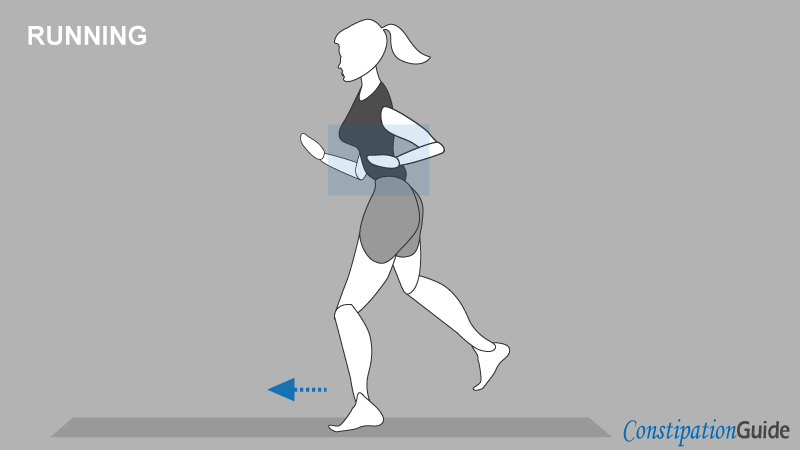
Running is the best cardio exercise because the results usually come after 2-3 sessions.
Running is an excellent way to improve endurance resistance. It also makes the body get used to intense physical activity.
Here is how to use running for constipation relief in the long-term: run for at least 50 minutes, once every 3-4 days.
In this way, you will have a continuous increase in endurance resistance and strength. Any pause larger than four days between training will slow the progress (human physiology).
This exercise makes all the body parts work, especially the legs and the lower abdomen.
After forty minutes of running, the body will start to use the fat deposits. Also, all of the internals will work, move, contract, and expand together.
This thing is beneficial for the Gastro-Intestinal Tract because it makes the stool move towards evacuation.
Also, running requires a constant rhythm of intense breathing, which makes the lungs expand. This thing makes the small and large intestines contract and move. As a result, the fecal matter inside will move with ease.
6. SWIMMING
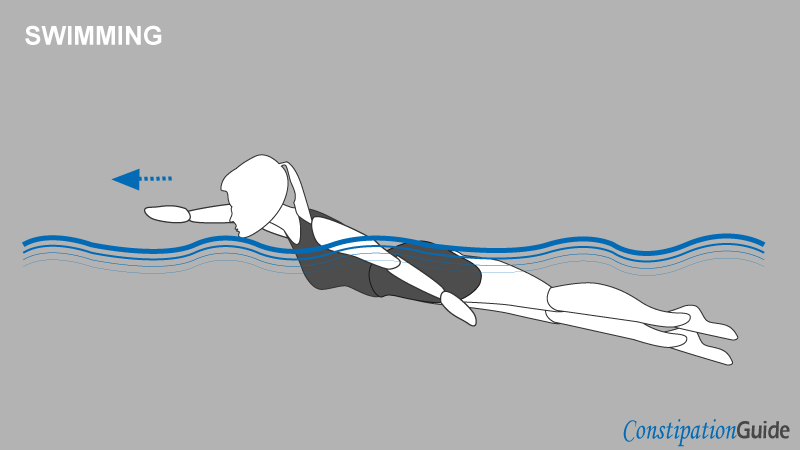
Swimming is the king of cardio exercise because it puts to work every inch of your body.
This exercise puts to intense workout the shoulders, the arms, the palms, and the entire abdomen.
Also, it puts to work the lower abdomen, the hips, and the legs.
Together, the movements expand and contract every muscle in your body. Every part of the small and large intestine will naturally squeeze and contract.
In this way, the body will have natural and healthy bowel movements without straining. The Gastro-Intestinal tract will stay healthy, and digestion will improve.
Swimming is a high energy-consuming in the short term. In this way, your body will consume every bit of fat stored on the tissues and liver. Also, the food that you ate will disappear in no time.
There is no rule on how to use swimming for constipation relief. The reason is that the moment you go into the water, you are already exercising.
But 10-20 minutes of slow swimming will be enough (20-30 min ideally). You can try styles like freestyle, backstroke, butterfly, or sidestroke.
7. JUMP ROPE
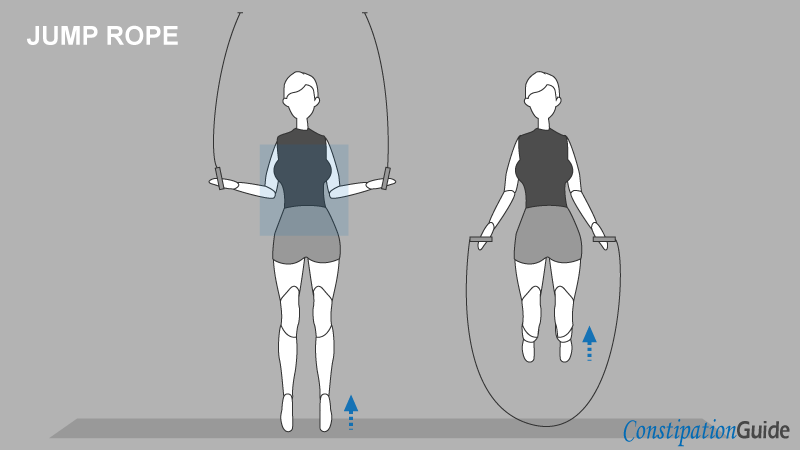
The jump-rope exercise is one of the most intense exercises to relieve constipation because it puts all the muscles to work immediately.
This exercise is an excellent cardio workout because it builds endurance resistance and creates adrenaline (stress relief).
Warm-up with 5-7 slow jumps and take a pause. Do 5-7 repetitions and stop.
Next, do another 10-12 jumps and try to rotate the arms as much as you can, and keep the rope in place.
Take a pause and repeat. End with 5-7 more slow jumps. Try to exercise once every three days.
The jump-rope exercise increases breathing and heart rate immediately. Keeping the knees up will stimulate the natural squeezing of muscles around the intestines.
Also, they move the stool towards evacuation. As a result, your body will start to function more efficiently.
According to a study called Jump Rope Training, published by The U.S. National Library of Medicine: The jump-rope exercise is a widely-used and practical method of developing athletic conditioning.
8. DEEP SQUAT
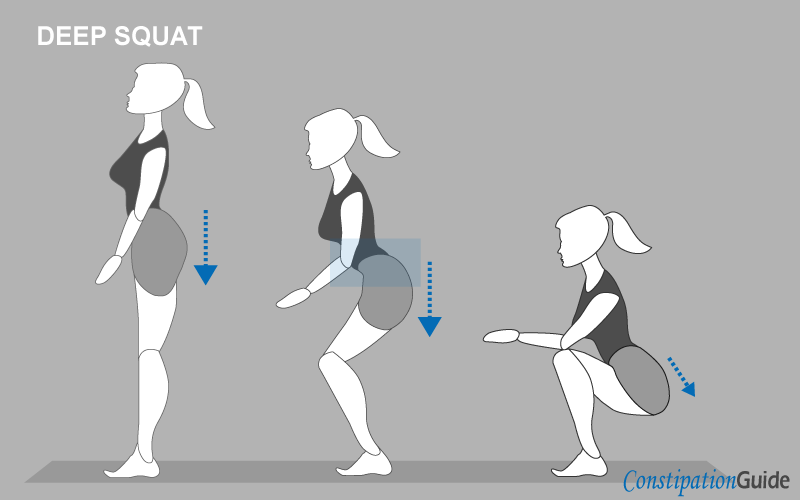
Another exercise that has incredible results with constipation is the deep squat.
This exercise has fast results because it imitates the natural defecation posture of humans.
Try to do 2-4 series of 5-10 repetitions of this exercise. Start slow with 10-12 repetitions of raising and lowering your body slowly and gently.
After the warmup, try to stay 5-10 seconds in the squatting posture.
The posture (knees higher than hips) increases the anorectal angle. This thing makes defecation feel natural.
Also, the deep squat exercise is excellent for working the pelvic floor muscles.
As a result, the time it takes for the stool to move through the large intestine and evacuate will decrease. The efficiency of the digestive tract and digestion will improve overall.
According to a guide called Why Exercise is Wise published by The Nemours Foundation: Squats and leg raises are excellent workouts to strengthen the legs.
9. SUPINE TWIST
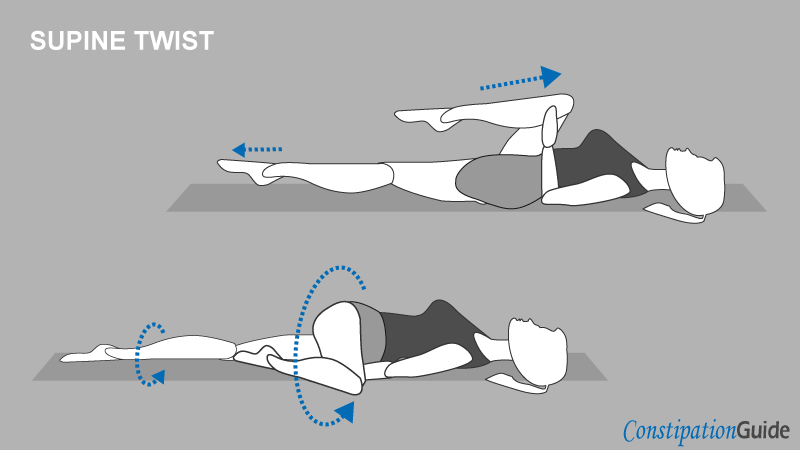
The supine twist is a yoga pose that uses body twists to stimulate abdominal contractions and intestinal squeezing.
Lying on the back and bringing your knees to the chest works the pelvic floor muscles.
The twist of the body from left to right stimulates bowel movement and sculpts the abdomen.
For long-term constipation relief, try to do 10-15 repetitions on both left and right sides of the body.
Repeat this exercise 3-5 times with slow and gentle movements to get the best results.
This twist increases the blood flow to our gut. It also helps to move the food through the intestines and expel the waste with ease.
10. COBRA STRETCH
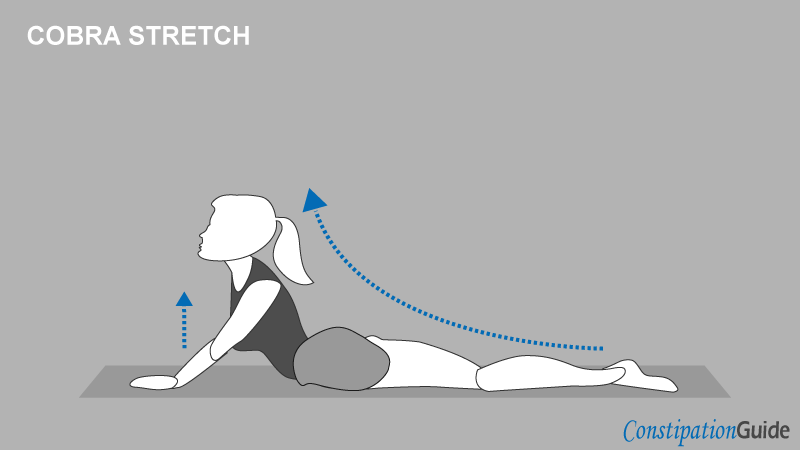
The cobra stretch is one of the most efficient exercises to relieve constipation because it encourages the digestive tract to pass hard and dry stool or gas with ease.
The cobra stretch involves moving the body from a straight posture to a bent body posture.
The upper abdomen bends towards the ceiling, while the lower abdomen bends towards the floor.
Try to raise your upper abdomen 3-5 times slowly and gently (warmup).
Continue with 10-20 repetitions and pause. End with another 3-5 slow movements.
This posture creates tension inside the abdomen that makes the abdominal muscles contract and expand. In this way, the dry stool moves through the intestines with ease.
According to a study about Yoga and IBS published by the U.S. NCBI: Start yoga by mastering to control the body and sit comfortably in any pose. You will be able to get relief from many symptoms and master breathing exercises.
11. WIND-RELIEVING POSE
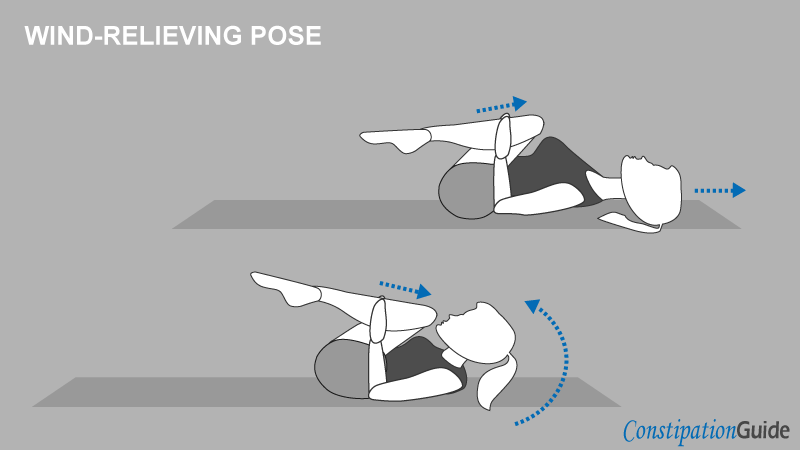
The wind-relieving pose is an excellent yoga pose for anyone to practice.
This pose is helpful for stress relief in the long term, increasing blood flow and stimulating bowel movement.
Start by doing 5-10 slow movements. Continue with 15-20 repetitions slowly.
Try to block the knees near the chest for more than five seconds and release them.
This yoga pose is excellent to practice at any time during the day.
All you need is a yoga mat and some sports clothes. The movement involves adopting an horizontal squat posture (similar to the deep squat) and returning to a straight body posture.
This pose is the combination of crunches and the deep squat. Therefore, it is an excellent workout for pelvic floor muscles.
According to a health guide called Diabetes Diet, Eating and Physical Activity, published by the U.S. NIDDK: Yoga is excellent for stress relief. Yoga focuses on breathing techniques and helps balance and body movement.
12. CLOCKWISE HIP STRETCH

Another excellent exercise to relieve constipation is the clockwise hip stretch.
This exercise is efficient because it puts to work the lower abdomen and the pelvic floor muscles.
The movement that this exercise involves (rotating the hips and legs) will help constipation by lowering the time it takes food to move through the intestines.
By intestines, we mean mainly the large intestine because digestion takes place in the small intestine.
If you hydrate properly during and after a workout, the body will have enough water to absorb. This thing means that the stool will have enough water to make defecation feel natural.
According to a health guide called Constipation and Defecation Problems, published by The American College of Gastroenterology:
We can prevent constipation by having an adequate intake of liquids and sufficient exercise. To have better results, we can combine workouts with a high-fiber diet.
Studies show that physical activity decreases colonic transit time. Also, exercise protects against gastrointestinal symptoms like constipation.
13. UP AND DOWN SHOULDER STRETCH
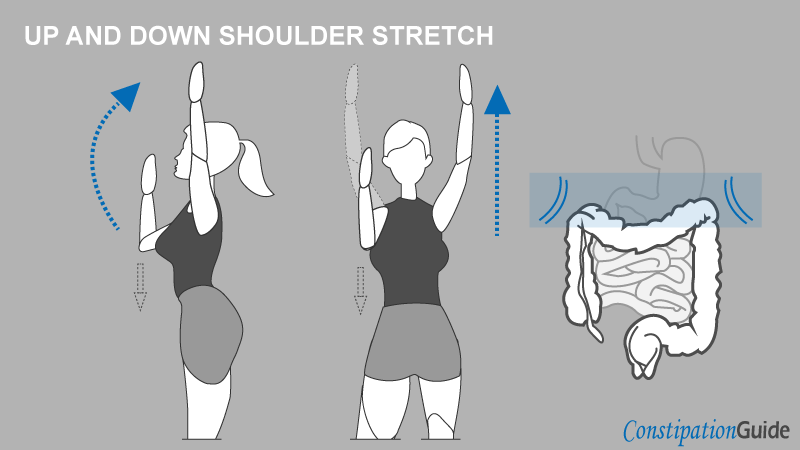
The Up-And-Down Shoulder stretch is a simple shoulder warm-up. People who recover from shoulder injuries use this exercise often.
Also, people who want to work the arm muscles use this exercise before lifting weights.
Raising your arms and palms (one at a time) in a continuous rhythm will work the upper abdominal muscles.
The movement will expand, contract, squeeze the intestines and create pressure. It will move the stool towards evacuation.
Start with 5-10 slow movements on each arm.
Continue with 10-12 slow and gentle arm raises on each hand. Continue with 10-20 slow repetitions and end. Over time, you can gradually add 10-20 repetitions to the workout.
Up-and-down shoulder stretches are excellent recovery exercises.
They prevent shoulder injuries, muscle soreness, wrist injuries, and strengthen the shoulder. This exercise is perfect for people who stay at a computer all day.
WHEN IS THE BEST TIME TO EXERCISE?
The best time to do any exercise to relieve constipation is two hours after having a meal rich in carbohydrates.
Any carbohydrate meal will digest in two hours maximum.
Example: whole wheat, whole bread, rice, pasta, bakery products, cheese products, yogurt, vegetables, beans, cauliflower, carrots, etc.
The best time to do any exercise after eating a meal rich in fats and meat is four hours after having this meal.
The reason is that: it takes 4-6 hours for the small intestine to digest meat and fats. This process requires slow food assimilation using blood and enzyme secretion.
WHEN TO EXERCISE DURING THE DAY?
It is essential to do any exercise in the morning.
Exercise creates adrenaline. Adrenaline is the type of chemical that keeps your body in a good mood, ready for action.
Adrenaline is a good remedy for stress, and it makes the body more relaxed. The effect goes away after 4-5 hours.
That's why it is better to do exercises in the morning. Some people can exercise in the evening, but adrenaline will keep them awake during the first half of the night.
Mild physical activity relieves bloating and reduces intestinal gas. Moderate and intensive physical activity improves health and IBS symptoms (20-60 min, 3-5 days/week).
Adults should exercise (moderate intensity) and should strengthen the muscles for at least 150 minutes, two or more days per week.
WHAT TO EAT BEFORE WORKOUT?
Whole foods are the best ones for digestion. The following ones are the best foods to eat before a workout:
- whole wheat
- whole pasta
- whole bread
- whole rice
Whole foods have a low glycemic index, and they have lots of fiber. That’s why they will help you lose weight.
If you combine them with fresh vegetables, you will get more vitamins and nutrients.
Vitamins and nutrients help to hydrate the body. Also, whole foods help clean the intestinal lining and digestion overall.
You can also eat a fruit salad made out of apples, grapes, prunes, and oranges. Strawberry and Raspberry are the best fruits to eat because they contain fiber and small quantities of fructose.
KEEP IN MIND
If you feel any discomfort or irritation around the abdominal area, you should stop doing any exercise.
If abdominal irritation persists for more than four weeks, then you should visit a doctor.
Also, if you become more dehydrated than usual after a workout, then consider visiting a doctor.
And ask to take some blood, urine, and stool tests. Always start slow because it takes some time for your body to adapt to physical activity.
According to a study called Anatomical Correlation of Core Muscle Activation in Different Yogic Postures: Yoga is beneficial for balance and body strength.
SUMMARY
You can use all of these exercises to relieve constipation both in the short and long term.
Cardio exercises like walking, running, jump rope, and swimming increase blood flow, build endurance resistance, and improve bowel movement.
Abdominal exercises like crunches, sit-ups, and the wind relieving pose focus mainly on the abdomen. They create pressure and sculpt the abdominal muscles.
These things make the digestive tract more efficient by moving the stool faster through the intestines.
Yoga exercises like the supine twist, deep squat, and cobra stretch help relieve stress. They bend and twist the body.
In this way, the abdominal contractions will naturally squeeze the intestines.
Stretches (clockwise hip stretch) and the (up and down) shoulder stretch work the entire abdomen. They are helpful to prevent muscle soreness and increase blood flow.
Last medically reviewed on 22.04.2022